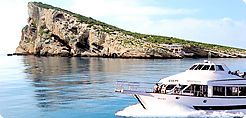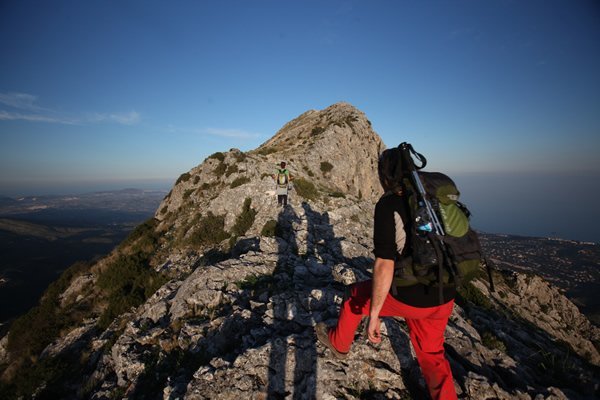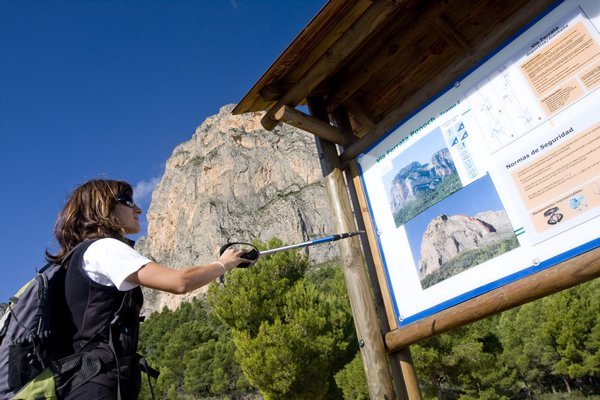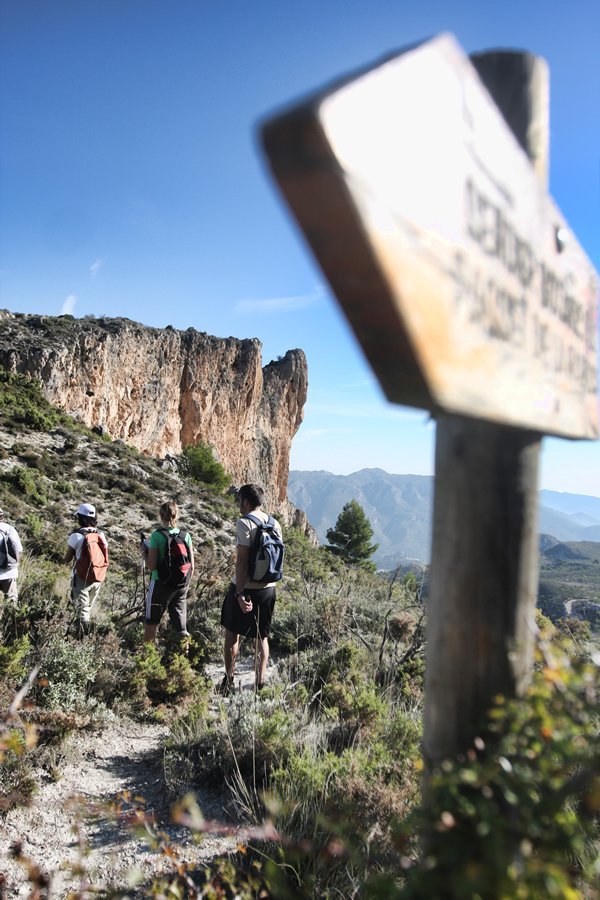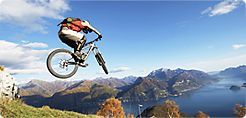Living Nature, Just Half an Hour from Benidorm
Although best known for its sunshine and beaches, Benidorm also boasts many other attractions that make it an ideal destination for lovers of nature and outdoor activities.
Home to some of the tallest skyscrapers in Europe, Benidorm is nestled within a natural amphitheatre of mountains whose majestic presence enhances its coastline and offers protection from the cold and the wind. Less than half an hour’s drive from the city, various peaks await, criss-crossed by scenic trails hiding treasures ready to be discovered by nature lovers in search of outdoor adventure.
Walking among pines, holm oaks, and Mediterranean oaks, along paths filled with the scent of lavender, thyme, and rosemary, becomes a delightful experience that awakens the senses and helps purify both body and spirit.
EL PUIG CAMPANA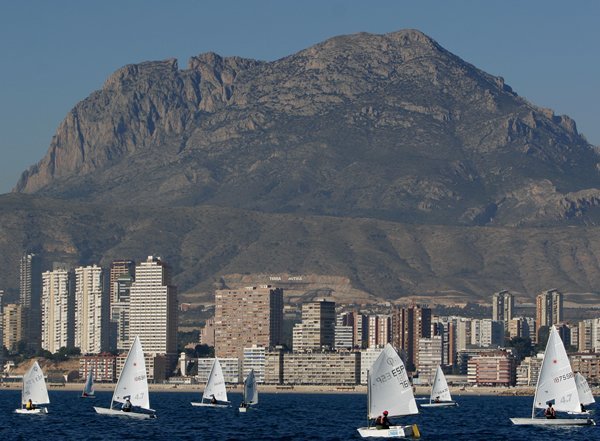
One of the most striking natural landmarks of the Costa Blanca is the iconic Puig Campana, the second-highest peak in the province of Alicante. Rising to 1,408 metres and located just 10 kilometres from the coast, it creates a dramatic visual impact on the landscape.
Situated in Finestrat, this mountain is shrouded in mystery, thanks to its distinctive shape, which has inspired numerous legends. The spectacular notch at its summit continues to fire the imagination of all who behold it. According to local folklore, the missing piece of rock was flung into the sea, forming what we now know as Benidorm Island.
This legendary cleft continues to captivate visitors, many of whom hike up to see the mysterious island emerging from the vastness of the sea below.
The most popular trail is ‘La Volta a la Serra’, while the ‘Ascent of Puig Campana’ is a slightly more challenging route. A third option is the ‘Camí de la Cova del Roget’. These routes are of moderate to low difficulty, making them suitable for a wide range of walkers. Depending on the path chosen, the hikes typically last between four and six hours. All routes begin at the Font del Molí.
If you’re looking to enjoy a countryside walk by the sea, there’s no better place than the Serra Helada Nature Park in Benidorm. Just a few metres away rise spectacular cliffs that reach up to 300 metres in sheer height. The park spans three municipalities: Benidorm, l’Alfàs del Pi, and Altea.
There are several trails to explore, but perhaps the most fascinating is the one that runs along the edge of the cliffs from Benidorm to Albir. Your walk should begin at La Cruz (The Cross), the first high point of the sierra visible from the coast. From there, a series of ascents and descents will break the monotony of a continuous climb, taking you to the entrance of the Camino del Faro del Albir. The views from the cliffs, the fossilised dunes, and the unique vegetation are among the best rewards of this nearly 9-kilometre route, which typically takes around four hours to complete.
For those who prefer a gentler walk suitable for the whole family, the best option is the popular Path to the Albir Lighthouse. This route requires minimal physical effort and is easily accessible. In just under an hour, you can complete the round trip along this charming 3-kilometre trail. The path leads to enchanting little coves and passes by an old ochre mine. From the viewing points along the way, you can enjoy stunning views of the bays of Albir and Altea, as well as the majestic Peñón de Ifach in Calpe.
Altea offers yet another fascinating option for outdoor adventure: the Sierra de Bèrnia, whose jagged ridge runs perpendicular from the coast inland, acting as a natural border between the Marina Baixa and Marina Alta regions. This spectacular mountain range stretches for around 11 kilometres from west to east, covering 1,900 hectares across the municipalities of Altea, Calpe, Callosa d’En Sarrià, Benissa, and Xaló. Its highest point rises to 1,128 metres above sea level, and from its summit, you can enjoy sweeping views of the coastline from Cape Nao in Jávea (Xàbia) to the port of Alicante. On clear days, you can even catch a glimpse of the island of Ibiza.
Bèrnia also holds a piece of local history. On its southern slope, King Philip II ordered the construction of the Fort of Bèrnia in 1562. Its purpose was twofold: to prevent uprisings among the Moriscos and to defend the coast from frequent raids by Barbary pirates. Today, at an altitude of around 800 metres, remnants of this historic fortification still remain—sections of the walls, vaulted structures, moats, and watchtowers offer a window into its past.
Yet nature has even more surprises in store within this mountain range, particularly the remarkable geological feature known as the Forat de Bèrnia, located at roughly 1,000 metres above sea level. One of the most unforgettable moments of the route occurs as you pass through this natural tunnel from the north face to the south. You must crouch down to pass through the narrow passage, which then opens up to sunlight and reveals the vastness of the sea stretching out before you—a truly breathtaking sight.
Another of the area’s outstanding offerings lies just 20 minutes from Benidorm, in Polop de la Marina, where the majestic Ponoig rises—better known as the Sleeping Lion, the symbolic guardian of this inland town in the Marina Baixa region.
With its striking vertical profile, this 1,181-metre mountain attracts hundreds of climbers throughout the year, eager to scale its walls and reach its summit. The cliffs of Ponoig soar up to 600 metres high, and their reddish hue has earned the mountain the nickname “The Spanish Dolomites.” Here, both traditional climbing and sport climbing are practised, and for thrill-seekers, a via ferrata offers a dramatic challenge at altitude.
However, Ponoig also caters to those seeking less extreme experiences, with a network of hiking trails that allow you to explore its beauty at a gentler pace. Notable routes include the Barranco de Xirles, the ascent via Margoch, Collado del Llam, El Salat, and l'Almàssera, each offering its own level of difficulty. Depending on the trail you choose, the hike can take from an hour and a half to four hours, especially if you're aiming to reach the summit and take in the breathtaking views from atop the Sleeping Lion.
If you're aiming to climb the highest peak in the province of Alicante, your challenge awaits in the Sierra de Aitana, the mountain range that also includes Puig Campana and Ponoig. The summit of Aitana rises to 1,558 metres, and one of its most striking geological features lies just before reaching the top: a massive rock formation with a narrow gap barely wide enough for a person to pass through. This feature gives it its name: “El Passet de la Rabosa” (The Fox’s Pass). From there, you can see directly opposite a ‘forat’—a hole that pierces right through the rock.
At the base of the mountain, at the well-known Font del Partegat, hikers are rewarded for their efforts with picnic areas and barbecues—perfect for enjoying a well-earned day out in nature.
Begoña Arija Coque.


